

|
Archive for the ‘Gluten-Free Recipes’ Category
Friday, October 22nd, 2010
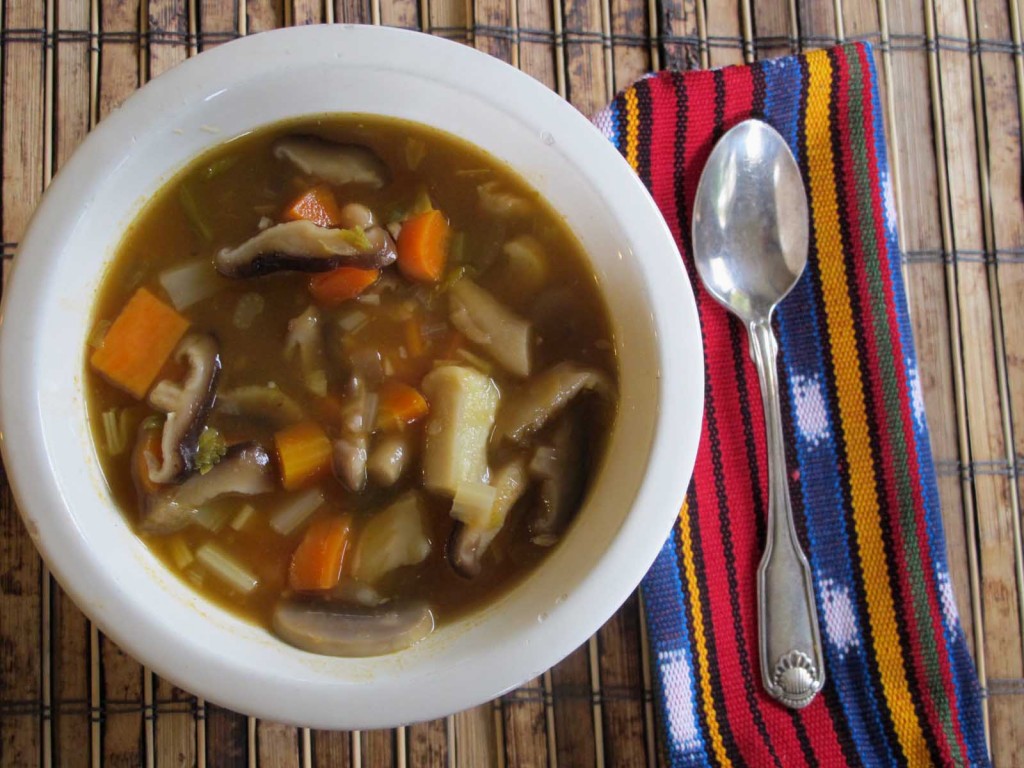
This month, Diane at The W.H.O.L.E. Gang is hosting Go Ahead Honey, It’s Gluten Free. Her theme is scary foods, or foods we’re reluctant to eat because they seem weird, strange or just plain creepy. Naomi, author of the blog Straight Into Bed Cakefree, is the creative genius-ette behind GAHIGF and if you check here, you’ll see she has an exciting list of themes and hosts scheduled all the way out to June of 2011. It’s beyond my comprehension to be that organized, but those of us who enjoy all these unique flavors and creative recipes are thrilled that Naomi keeps this party going in such grand style.
Although there are lots of foods that I find scary for health reasons, I know Diane didn’t mean nasty, processed foods full of chemicals, additives and dyes, so I had to dig deep to figure out a weird food that I’d actually buy, create a recipe for and eat.
Believe it or not, mushrooms hit my “creepy food” button. I use them occasionally, but usually in a puréed form. They add a wonderful earthy taste to soups and stews, but eating them in their slimy, cooked-but-not-puréed form weirds me out. The texture is way too booger-ish.
Having said that, here’s what I like about them (other than the earthy flavor they impart). Mushrooms have been used in TCM (Traditional Chinese Medicine) for centuries for everything from immune support to anti-aging, so they’re high on the list of well-studied medicinal foods. They’re considered an adaptogen in alternative healing circles and while I doubt they’re the cure-all many tout them to be, they truly are packed with health-enhancing nutrients. Plus, they’re low in calories, so you get a lot of bang for your buck.
I usually sauté mushrooms in coconut oil and blend them with vegetable broth in my VitaMix. That way I can add them to recipes and get all the benefits and none of the icky texture. I realize most people aren’t bothered by the slimy feel of mushrooms, but I’m not one of them. So, puréeing is a good way to reap the benefits and circumvent my gag reflex.
For this recipe, I used a mix of organic shiitake, shimeiji, abalone and field mushrooms from Woodstock Farms. I didn’t sauté them first, I just tossed them into my soup blend.
mixed mushroom and veggie soup
what you need
6 cups vegetable broth (I often make my own, but this time I used Pacific organic vegetable broth)
2 cups filtered water
1 onion, diced
4 to 6 garlic cloves, minced
4 to 6 carrots, chopped
4 to 6 celery stalks with leaves, chopped
4 tomatoes, quartered and roasted
1 and 1/2 cup mixed mushrooms
oil (some for sautéing the veggies, some for coating the tomatoes)
seasonings (I used Simply Organic all-purpose seasonings)
sea salt and freshly ground pepper
what you do
1. Preheat oven to 400 degrees. Wash and quarter tomatoes. Place in bowl, drizzle with a little olive oil and sprinkle with sea salt and freshly ground pepper. Toss gently. Place skin side down on a cookie sheet and place in oven for about 30 minutes.
2. While the tomatoes are roasting, heat a glug of the oil in a heavy soup pan. Add the onions and cook for 4 to 6 minutes. Add the garlic, celery and carrots and cook for a few more minutes, stirring often.
3. Add the vegetable broth and simmer on low for about two hours.
4. Place the tomatoes (be careful blending if they’re still hot) and the filtered water in a blender and blend well. Pour into the soup mix.
5. Once the veggies are cooked, but still slightly crunchy, add the mushrooms and cook for another hour or so.
6. Add seasonings (an herb blend) and salt and pepper. Simmer for a few more minutes. Serve with gluten-free corn bread.
Peace, joy and mushroom love.
Melissa
Thursday, October 14th, 2010

This post was inspired by the people in my family (that would be Bill and Tevis) who have a funky allele from the shallow end of the “food sensitivity” gene pool. That little chromosome modification makes eating raw lettuce a digestive disaster.
Lettuce?
Yes, there are people who can’t eat raw lettuce. How weird is that? (This coming from someone who can’t eat gluten, bell peppers, black beans and eggplant. Or oysters, but that’s just because they’re icky.)
So, who says you have to eat lettuce raw?
Remember, you are the boss of your food. I find lettuce absolutely delicious sautéed and mixed in with other veggies and brown rice. Just like you would spinach or kale. What’s the difference? They’re all leafy and green.
sautéed lettuce and brown rice bowl (a favorite lunch of mine)
what you need
1 cup cooked brown rice (I love Golden Rose, but any brown or wild rice will do) *
1/4 cup chopped onion
1/4 cup chopped carrot
1/4 cup chopped celery
2 cloves minced garlic
1 to 2 cups washed and chopped lettuce (a thick and leafy type is best)
Spoonful of coconut oil (or oil of choice)
Several splashes of vegetable broth
Sprinkling of Parmesan cheese and roasted nuts (optional)
Dusting of gomasio * (or dried herbs, sea salt and freshly ground black pepper)
what you do
Heat oil on low/medium heat in a large skillet. Sauté onions, carrots and celery for 5 to 7 minutes, stir often. They should be lightly cooked, but still crunchy. Add garlic and cook another 2 to 3 minutes. Add rice and blend with veggies. If your rice is cold (cooked, but has been refrigerated), make sure you cook it long enough to heat it up. Add a splash of vegetable broth just enough to moisten the mix and prevent the rice and veggies from sticking to the pan. Add the lettuce and another splash of broth and stir well. Keep stirring and cook for another 3 to 5 minutes until lettuce is wilted. You might even put the lid on the skillet and let it steam for a minute or two. Place in bowl, top with cheese and seasonings.
I’m not guaranteeing this will solve your food sensitivity problem, but many people have difficulties consuming raw veggies, lettuce included and they never think to cook it first. We cook all other veggies, why not lettuce?

I get lots of Romaine lettuce from my Grant Family Farms CSA share and find this to be a perfect choice for cooking (see above photo of chopped Romaine). It’s thick, crunchy and hearty, so it stands up well when thrown in the sauté pan.
* For detailed information on rice types and cooking tips, please check here.
* For a wonderful gomasio recipe, check here.
Peace, love and cooked lettuce.
Melissa
Monday, October 4th, 2010

1. What the average American consumes in one year (courtesy of Visual Economics, check here for the over-indulgent details).
• 53 gallons of soda
• 24 lbs of ice cream
• 141.6 lbs caloric sweetener, includes 42 lbs of corn syrup
• 24 lbs of artificial sweetener
• 600 lbs of non-cheese dairy products
• 110 lbs of red meat
• 134 lbs of wheat flour (who ate my 134 lbs?)
• a total of 1996.3 pounds of food per year
Seriously, how can 1 person (in 1 year) consume 600 lbs of dairy products, excluding cheese? Add in the 31.4 lbs of cheese the average American eats per year and that adds up to 632 lbs of dairy products. Yuck. Just the thought makes my nose stuffy and my head ache.
2. “Per calorie, cooked spinach has more than twice as much protein as a cheeseburger; lentils have a third more protein than meatloaf with gravy.”
Bittman, Mark. Food Matters: A Guide to Conscious Eating, page 85. Simon & Schuster, New York, 2009.
3. What does the word natural mean on food labels?
Not much, if General Mills’ Nature Valley Sweet & Salty Peanut Granola Bars are any indication. The product claims to be “only natural” and that you’ll always be getting The Taste Nature Intended (which is a General Mills registered phrase). Okay, here’s the label ingredient list. Is this what nature intended? Would you call this natural?
Ingredients: roasted peanuts, high maltose corn syrup, sugar, rolled oats, high fructose corn syrup, palm kernel oil, crisp rice (rice flour, sugar, malt, salt), wheat flakes (whole wheat, sugar, salt, malt), fructose, peanut butter (peanuts, salt), yogurt powder (cultured whey protein concentrate, cultured skim milk, yogurt cultures), canola oil, water, maltodextrin, salt, nonfat milk, soy lecithin, color (yellows 5 & 6 lake, red 40 lake, blue 1 lake, and other color added), natural flavor, almonds, baking soda, honey, sunflower meal, mixed tocopherols added to retain freshness.
Whew, did nature really intend for us to eat all that icky stuff? If nothing else, the list of dyes should be a tip-off that natural isn’t natural to the folks at GM. And what does “other color added” mean? Like yellows, reds and blues aren’t enough? And what does “natural flavor” mean in the midst of all that? Does that mean the other flavors are unnatural? My online dictionary/thesaurus includes “undyed, uncolored and unbleached” in its description of the word natural. UH-OH, I can no longer call myself (or at least my hair) natural as I occasionally have “other color added” in the way of a few sun-kissed streaks here and there. Don’t tell anyone.
Bottom line? The food industry has a weird and skewed definition of the word natural. Make your own granola bars. Check here for one of my recipes. Or, here for one of Shirley’s recipes at Gluten Free Easily.
4. Who hates Brussels sprouts?
Whoa, almost all of you? Okay, here are some tips and facts to help you warm-up to Brussels sprouts.
• Don’t overcook them as it promotes the release of those unpleasant (and stinky) sulfur compounds that give them a bitter taste. It also destroys the vitamin C. Quick cooking leaves the delicate, nutty flavor of the vegetable. You can also eat the leaves. It’s okay, I promise.
• To retain nutrients and flavor, quick steam, stir fry or quick roast sprouts. Sauté the leaves with other veggies in a touch of coconut oil and mix with brown rice.
• Hold sprouts in your hand and choose the ones that feel heavy for their size. If possible, pick sprouts still on the stalk and buy the smallest stalk. Those are the sweetest.
• One cup (60 calories) of Brussels sprouts provides 273% of the recommended daily value of vitamin K and 161% of the recommended value of vitamin C. They’re also high in folate and vitamin A, along with a host of other cancer-fighting, anti-inflammatory, heart healthy, detoxing, and health-loving plant chemicals. These little gems are the real deal, hundreds of research studies have taken place on the health benefits of Brussels sprouts.
5. Gomasio
I love this stuff. It’s SO good sprinkled on salads, rice, quinoa, soups, stews, sautéed veggies, Brussels sprouts (see above). Be creative, sprinkle outside the lines.
Here’s a simple (and wonderful) calcium-rich, nutty, yummy condiment. The sesame seeds provide lots of bone-building nutrients. They’re high in calcium, magnesium, iron, phosphorus and zinc – and rich in fiber. One fourth cup of sesame seeds also contain 74% of the recommended daily value of copper. Studies show that copper may help people suffering from rheumatoid arthritis. Good stuff, although not low in calories (high oil content) so keep that in mind. Store in a glass jar in a cool, dark, dry place.
• 1 cup white sesame seeds
• 1 teaspoon freshly ground sea salt
In a small skillet, dry roast the seeds on medium heat for about 5 minutes, stirring often until they begin to brown. Using a blender or mortar and pestle (I use a mortar and pestle), blend or crush together the warm sesame seeds and salt. Use immediately or store in an airtight container in the refrigerator for several weeks. Recipe from The Kripalu Cookbook: Gourmet Vegetarian Recipes.
* You can also add dried garlic or dried celery to the mix.
Peace, love and REAL natural food!
Melissa
Saturday, September 25th, 2010
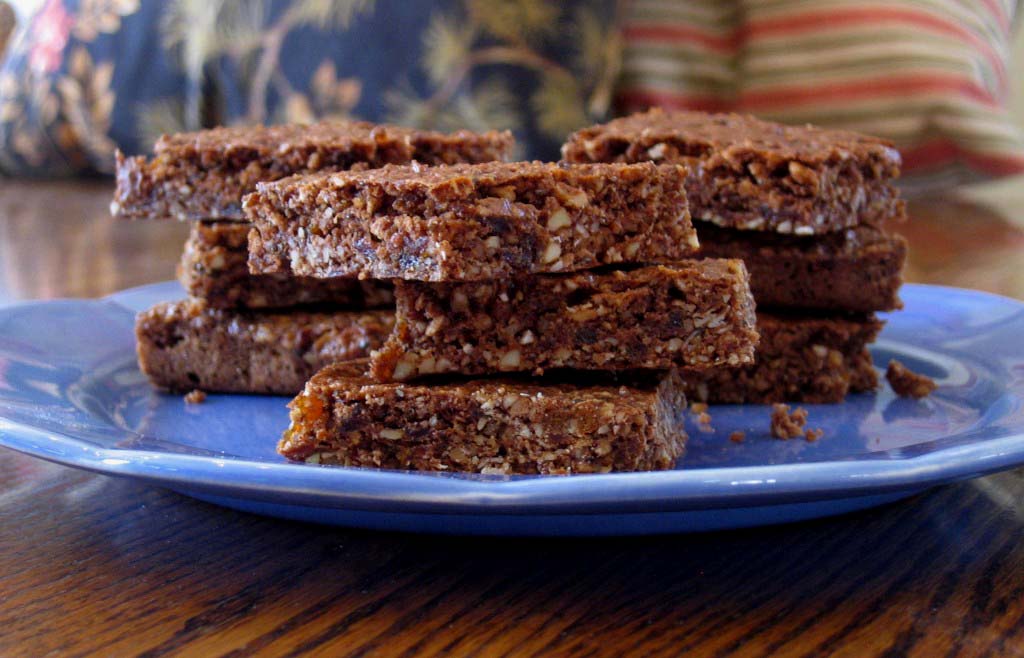
When Ali (co-owner, with her husband Tom, of Whole Life Nutrition) asked me to participate in her kid-friendly “Go Ahead Honey It’s Gluten Free” event, my first thought was, “Hallelujah, I’m not packing lunches anymore because my kids are all grown, ha-ha-ha.”
But after my initial jubilation, I had a sudden jolt of nostalgic sadness over the fact that my lunch packing days were over. Okay, if you must know, that passed quickly, but I decided it would be fun to participate anyway.
Plus, I’m into healthy environments for kids and a big part of that has to do with what they eat. My kids never bought school lunches. They went to a closed-campus high school and couldn’t wander off to MacDonalds (thank goodness), so over the years, I made a LOT of lunches. And with two boys and two girls, the lunches were often customized and large.
I love Ali and Tom’s approach to food, nutrition and parenting, so here’s my contribution to the lunch room party.
kid-friendly power bars
what you need
1 cup pecans
1 cup almonds
1 cup chopped dried apricots, unsulphured (I use organic Turkish apricots)
1/2 cup (2.5 ounces) dark chocolate, coarsely chopped, 55% cocoa content or higher
1/4 cup gluten-free rolled oats *
1/4 cup Pamela’s GF Baking Mix
2 tablespoons ground chia seeds
1 teaspoon ground cinnamon
1/4 teaspoon sea salt
1/3 cup pure maple syrup (I like organic, grade B)
1 large egg
1 teaspoon vanilla
* I use guaranteed gluten-free oats from Montana Gluten-Free Processors. Oats are generally safe for most people who are gluten-intolerant, but make sure the oats you use are uncontaminated and guaranteed gluten-free. Montana Gluten-Free Processor oats are certified by both the Gluten Intolerance Group and the Celiac Sprue Association.
what you do
1. Preheat oven to 325 degrees. Line a cookie sheet with parchment paper. Spread the pecans and almonds in a single layer on the prepared cookie sheet and roast for 6 to 10 minutes, or until fragrant and lightly browned. They burn easily, so watch them and stir once or twice if needed. Let cool.
2. Place flour, ground chia seeds, cinnamon and salt in a food processor and pulse until well combined. Add nuts and pulse until they are coarsely chopped and well blended with the other ingredients.
3. Add oats, apricots and dark chocolate and pulse several times so everything is mixed together.
4. In a large bowl, whisk together egg, maple syrup and vanilla. Make sure these ingredients are well blended. Add the nut and fruit mixture to the bowl. Using a fork, mash and mix them all together, breaking apart clumps of dried fruit and chocolate.
5. Spread the mixture over parchment paper onto the cookie sheet. Either flatten the mixture with your hands or place another sheet of parchment paper on top and roll out into a flat sheet, about 1/4 to 1/2 inch thick. Remove the top piece of parchment paper and bake on center rack of oven for 24 to 28 minutes until nicely browned. Don’t over-bake them. Cool completely on a wire rack before cutting into bars. Store in the refrigerator. Makes about 2 dozen bars.
If you don’t have kids at home, make a batch of these and use them for a quick pick-me-up while out hiking or skiing. They make great back-country power bars.
Peace, love and good nutrition!
Melissa
Friday, September 17th, 2010
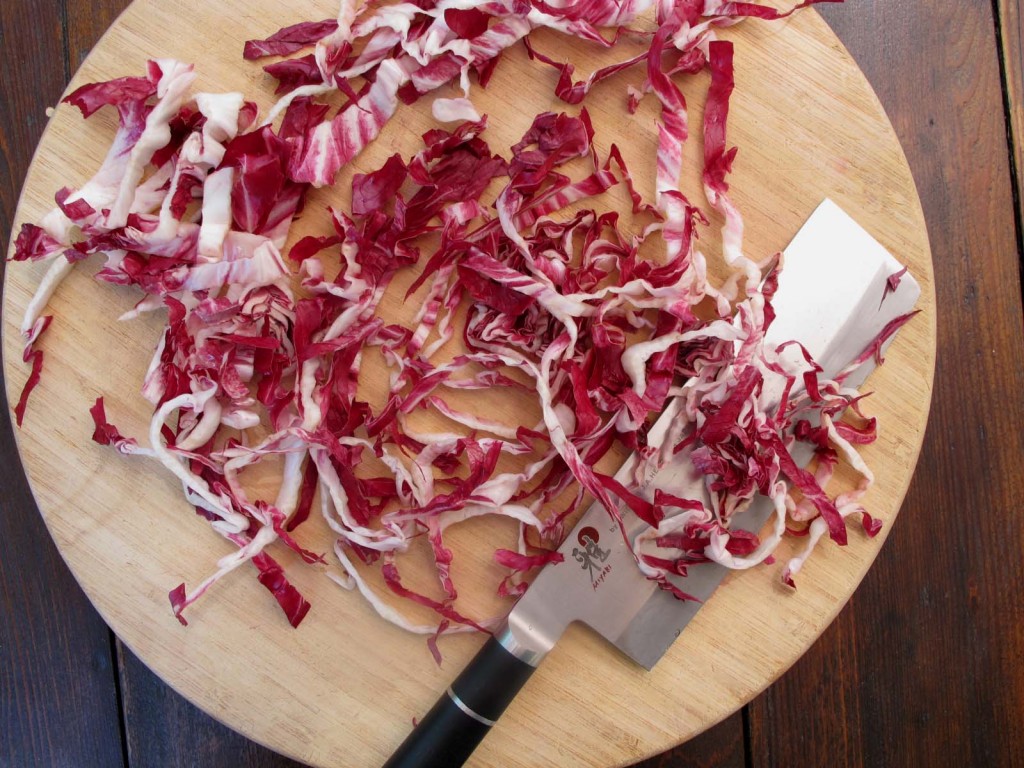
I figure if I’m going to eat pizza, I better load it up with antioxidant goodness.
Wednesday is my Grant Family Farms CSA pick-up day, so Tuesday nights are often spent making pizza or rice bowls out of the leftover odds and ends in my crisper drawer. It forces me to explore the dark corners of my fridge and make room for the new arrivals. Never one to color inside the lines, I’ve come up with some creative ways to use the tail-end of my farm-fresh food deliveries.
Beet or corn ice cream, anyone? Sweet potato tacos?
How about radicchio, mixed squash and beet pizza?
Radicchio?
Radicchio (see above) is a leafy chicory plant. Most people use it in salads, although I find it bitter. But guess what? If you cook it, the bitter taste disappears and it becomes mellow and slightly sweet. It’s wonderful stuff and according to The Journal of Nutrition, it’s also very high in antioxidants. Right up there with Swiss chard, spinach and broccoli.
Last Tuesday night I dug around in my fridge and found some radicchio, a piece of already cooked corn-on-the-cob, a beet, a small grilling onion, two roasted green chiles, and a few big chunks of delicata, crookneck and zucchini squash. I also had several garden-fresh tomatoes, all from the farm.
Radicchio on pizza? I’ll give it a try. And, how about roasted green chile, black olive, onion, corn and tomato pizza?
All super-healthy ingredients. Every veggie on this list is filled with high-quality antioxidants. That’s a good thing. Our bazillions of hard-working little cells need all the help they can get.

gluten-free antioxidant veggie pizza #1 (see above, top left corner)
what you need
1 gluten-free Udi’s thin pizza crust *
1 & 1/2 tablespoons butter (I prefer organic, pastured, full-tilt butter)
2 cloves garlic, minced
squeeze of honey (1-2 teaspoons)
1 cup thinly sliced ridacchio
1 cup mixed squash chunks (3/4 inch squares)
1 beet, washed and cut into chunks, no need to peel (3/4 inch squares)
cheese (I used a mix of 3 different kinds)
gluten-free antioxidant veggie pizza #2 (above, bottom right corner)
what you need
1 gluten-free Udi’s thin pizza crust *
1 & 1/2 tablespoons butter
2 cloves garlic, minced
squeeze of honey (1-2 teaspoons)
2 roasted green chiles, peeled, de-seeded and chopped
2 tomatoes chopped *
1 can sliced black olives
1/4 cup corn
1/4 cup diced onion
cheese
what you do
1. Because the beets and squash take longer to cook than the pizza itself, I like to roast them first. It also adds a nice taste to the pizza. Preheat oven to 400 degrees. Place the prepared beets and zucchini in a medium-sized bowl and drizzle with a small amount of olive oil. Gently mix to cover with oil. Spread out the veggies on a lightly oiled cookie sheet and sprinkle with sea salt. Roast on center rack of the oven for about 15 minutes. Watch closely and flip using a spatula to make sure they’re roasted evenly. Remove from oven and set aside.
2. While the veggies are roasting, melt the butter over low heat, add the garlic and honey and stir until blended.
3. Brush the melted butter-garlic-honey blend over the pizza crust. Add the ingredients, sprinkle shredded cheese over the top and cook in 375 degree oven for 10 to 12 minutes or until the cheese is lightly browned. Remove from oven and let rest for 5 minutes.
4. Cut into 4 slices and enjoy! Serves 1 or 2, depending on how hungry you are.
Melissa’s cooking notes (if you dare):
* Udi’s is a local gluten-free product company. These crusts are thin, delicious and store well in the freezer. This is one of the few pre-made, gluten-free products that I buy. I love them!
* Put the ridacchio on first so it doesn’t burn (that goes for ingredients like kale as well, they tend to cook faster than the big chunky ingredients).
* When I use tomatoes for cooking and don’t want the extra liquid, I chop them and spin them in my salad spinner to get rid of the excess moisture. Then I save the juice and use it in my homemade salad dressings.
* Photos above are the “before” versions. I dislike messing with my camera when it’s time to sit down and enjoy dinner.
Peace, love and antioxidant goodness!
Melissa
Friday, July 16th, 2010
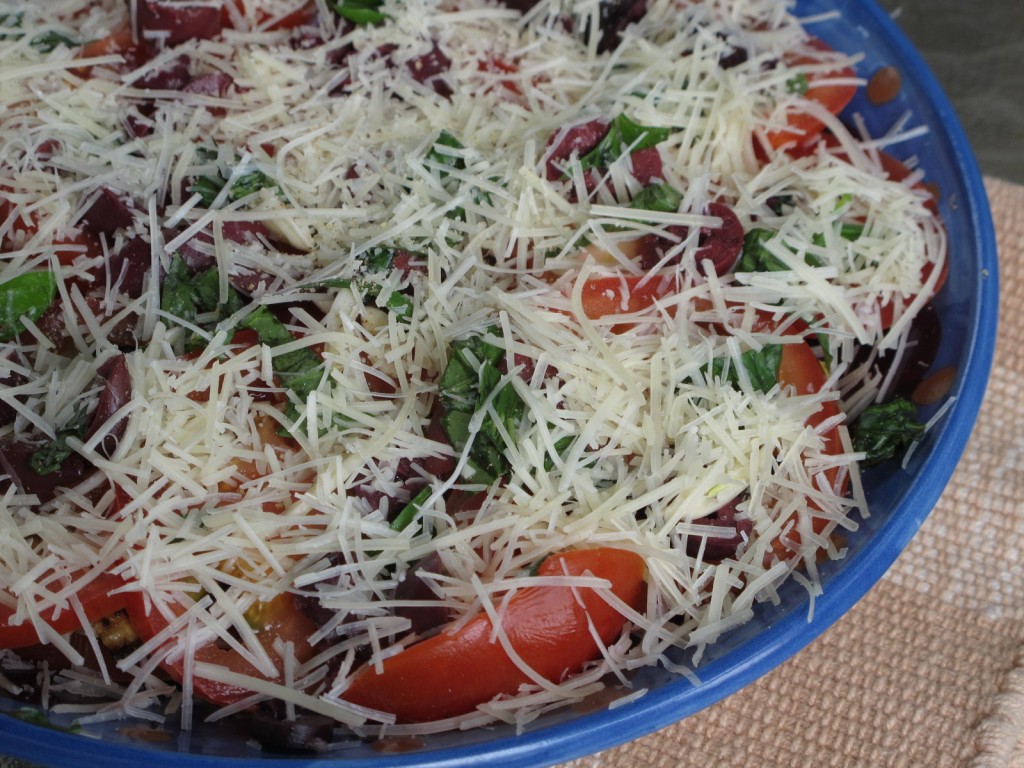
I suppose this should be called a zucchini tomato basil au gratin, sans gluten-cootie bread-crumbs. The photo above is the uncooked version. I have a problem with making people (me included) wait to eat until I fuss with taking a photo, so I prefer taking “before” photos of my food. I’m not the best “after” photographer, anyway. It’s hard to mess up a shot of beautiful, organic apples, but easy to end up with a slimy rendition of applesauce. Know what I mean?
This is an slight adaptation of a recipe I picked up from Vegetarian Times Magazine and I love it. It’s a bit of a pain, but well worth it. The prep work prevents the juicy veggies from releasing too much moisture. Soggy is not good, firm and hearty is. We’re also into zucchini season around here, so this has been on the menu recently. It’s great with grilled fish. Absolutely divine!
gluten-free zucchini tomato basil bake
what you need
4-6 tomatoes, cut into 1/4 inch thick slices
3-4 medium-sized zucchinis, cut into 1/4 inch thick, long slices
4 cloves garlic, thinly sliced (more if you’re a garlic fan)
4 tablespoons roughly chopped kalamata olives
1/4 cup thinly sliced basil leaves
1 cup shredded Parmesan cheese
olive oil
sea salt
freshly ground pepper
what you do
1. Drape sliced tomatoes over a colander, sprinkle with salt and let drain 45 minutes.
2. Place prepared zucchini slices on a baking sheet. Sprinkle with salt and let stand for 45 minutes. This sweats out the excess moisture. Rinse and pat dry.
3. Preheat oven to 375 degrees. Heat a small amount of oil in a skillet over medium heat. Sauté zucchini for a few minutes until golden brown. Transfer to a plate. You’ll have to do this in batches and add a touch more oil as you go.
4. Layer half the zucchini slices in a lightly oiled baking dish. Top with half the tomatoes, then half the garlic, olives, basil and cheese. Season with freshly ground black pepper. Repeat the process with the remaining zucchini, tomatoes, garlic, olives and basil. Drizzle with a small amount of olive oil (maybe 1-2 teaspoons) and top with the rest of the cheese.
5. Cover with foil and bake 10 to 15 minutes. Remove foil and bake another 20 to 25 minutes, or until cheese is melted, golden brown and the dish is bubbling. Let stand for 5 minutes and serve.
* My son took spoonfuls of this and spread it over big slices of crusty Italian bread. He said it was amazing (not that I would know). I’m going to try a version of this as gluten-free pizza. Doesn’t that sound good?
Peace, love and veggie au gratin!
Melissa
Monday, July 5th, 2010
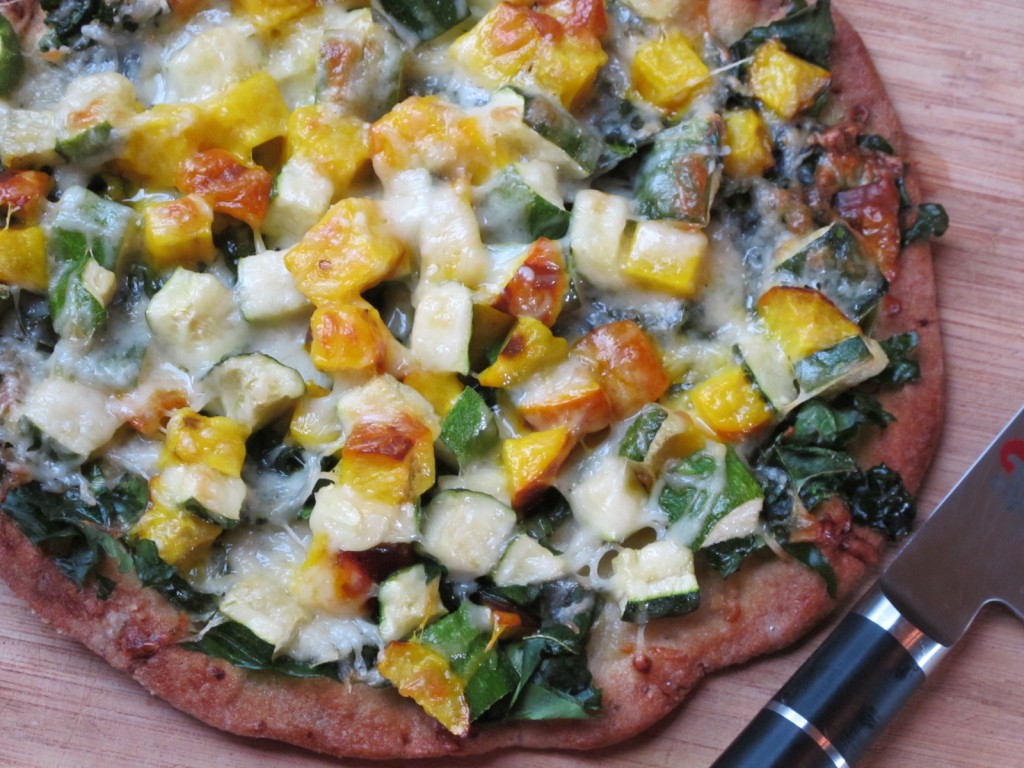
Pizza — laden with roasted golden beets, zucchini and vitamin-K-packed SPINACH.
I picked up my CSA delivery box this past week and guess what I found inside?
Whoa, how did you know?
Spinach, glorious deep-green spinach. And lots of it.
I’m not complaining because it’s the best spinach on the planet. It’s just that you have to get very creative with your recipe development when you’re in the deep-end of spinach season. Beet, zucchini and spinach pizza, anyone? Trust me, this was over-the-top delicious. But, before I launch into the recipe, please humor me (or skip this part) and let me wallow in my geek-ness.
Ready?
I have a theory about hearty greens (like spinach and kale) and celiac disease and gluten-intolerance.
Celiac disease is a genetically predisposed autoimmune disease in which gluten (the main storage protein in wheat, barley and rye) wreaks havoc on the small intestine, inhibiting nutrient absorption. That’s the super-duper, shortened definition. If you want the unabridged version, leave me a comment and I’ll fill you in on anything and everything you might want to know about celiac disease and gluten-intolerance. But for now, my theory about spinach and it’s role in healing.
Spinach is one of the most nutrient-dense (calorie for calorie) foods available. I bet the deep-green, leafy, organic stuff I get from Grant Family Farms is on the far-side of pharmaceutical grade. It’s packed with vitamin K – 1110% of the recommended daily value. It also contains a zillion other health-promoting nutrients, but to keep this post from becoming a thesis paper, I’m going to focus on vitamin K and celiac disease.
Without getting into the poopy (literally) details, unmanaged celiac disease can cause nutrient malabsorption. Fat soluble vitamins (A, D, E, and K), iron, folic acid and a large part of our calcium are absorbed in the proximal section (the top part) of the small intestine. That’s the area that receives the most damage when you have celiac disease. If you have a trashed small intestine and you’re not breaking down your food adequately or absorbing your nutrients efficiently, you won’t be absorbing your fats (to make a long story short). If you’re not absorbing your fats, you won’t be absorbing your fat soluble vitamins. If you’re not absorbing your fat soluble vitamins, you won’t get the full benefit of vitamin K.
This is a generality. Our bodies are amazing and we compensate in many different ways, but if you become deficient in vitamin K, your blood may not clot properly. Isn’t it interesting that our blood has this amazing ability to flow quickly throughout the body; up and down and all around? Think about it, it remains a flowing liquid. But if you cut yourself, it can become a solid within seconds. Whew, that’s a good thing. If blood didn’t clot, one pinprick could drain the entire body of all its blood. Imagine a water balloon with one tiny little hole in it. Eventually all the water would slowly drain from the balloon.
Does anyone out there bruise or bleed easily? Anyone with celiac disease? Hmmm?
Vitamin K also plays a role in the synthesis of bone proteins. Without adequate vitamin K, the bones produce a funky protein that can’t bind to the minerals that normally form bones. You see, it’s not just the calcium you need for strong bones, it’s also vitamin K (and a bunch of other things, including exercise).
Anyone with osteopenia or osteoporosis? And celiac disease? Hmmm?
One more geeky thing (maybe two) and I’ll get on to the pizza recipe. Vitamin K can also be obtained from a nonfood source. GI tract bacteria can synthesize vitamin K, but you need to have a healthy balance of intestinal bacteria for that to happen. Antibiotics also kill the vitamin K producing bacteria, so there are lots of ways to become deficient, especially if you have celiac disease.
Now, don’t go taking vitamin K supplements unless your doctor prescribes them. Fat-soluble vitamins aren’t excreted as easily as water-soluble vitamins, so the risk of toxicity is much greater. I’m a big fan of getting my nutrients from high-quality food. This kind of focus is called nutrition therapy – this is what I do and this is how I live (most of the time, anyway).
So, let thy food be thy medicine and go eat some spinach!
gluten-free, spinach, roasted beet and zucchini pizza
what you need
1 gluten-free pizza crust (I used an Udi’s pre-made thin crust on this pizza)
1 & 1/2 tablespoon butter
2 cloves garlic, minced
squeeze of honey (maybe 1-2 teaspoons)
2 small golden beets, scrubbed, trimmed and chopped into 3/4 inch cubes (no need to peel)
1 zucchini, washed and chopped into 3/4 inch cubes
2 cups spinach, washed, stemmed and chopped
grated cheese (I like a mix of shredded Parmesan, Romano and Asiago)
what you do
1. Because the beets and zucchini take longer to cook than the pizza itself, I like to roast them first. It also adds a nice taste to the pizza. Preheat oven to 400 degrees. Place the prepared beets and zucchini in a medium-sized bowl and drizzle with a small amount of olive oil. Gently mix to cover with oil. Spread out the veggies on a lightly oiled cookie sheet and sprinkle with sea salt. Roast on center rack of the oven for about 15 minutes. Watch closely and flip using a spatula to make sure they’re roasted evenly. Remove from oven and set aside.
2. While the veggies are roasting, melt the butter over low heat, add the garlic and honey and stir until blended.
3. Brush the melted butter-garlic-honey blend over the pizza crust. Add chopped spinach first, then beets and zucchini. Sprinkle shredded cheese over the top and cook in 375 degree oven for 10 to 12 minutes or until the cheese is lightly browned. Remove from oven and let rest for 5 minutes.
4. Cut into 4 slices and enjoy! Serves 1 or 2, depending on how hungry you are.
* I’ve also made this pizza with red beets, but I kept the beets separate while preparing them so that everything else didn’t turn pink (not that it matters).
Udi’s is a local company. The pizza crusts are gluten-free, soy-free, dairy-free, nut-free and delicious. Gluten-cootie-eaters don’t even know they’re gluten-free. No apologizing, no explaining needed!
Peace, love and vitamin K!
Melissa
Monday, June 28th, 2010

Well, that’s what it looked like. Murky, camo-green and all.
Plus, I’m hooked on alliterations, and those “s” words flowed together so well. Although I must say, swamp scum probably isn’t the most keyword-worthy phrase. Not that I’ve ever cared much about keywords. In my own blog world, anyway. If I write copy for you, I’m TOTALLY into keywords. TOTALLY.
I suppose if I’m going to take this blogging thing seriously, I should start thinking tagline options, SEO, keywords, analytics and metadata. Don’t you think? After all these years?
Nah.
Just the mention of metadata gives me brain freeze. And without the accompaniment of a huge bite of ice cream, that’s just not fun.
Okay, on to the serious business of figuring out what to do with all this spinach. I’m almost sure someone at my CSA pickup location slipped some of their spinach into my box.
Fine. If anyone can manage an abundance of spinach, it’s me. I’ll take on the challenge.
Nancy Drew meets the Green Goddess (ooh, that would have been a great title).
swamp scum smoothie
what you need
SPINACH (if you don’t have any, I’ll share), washed with stems *
1 golden beet unpeeled, scrubbed, trimmed and chopped *
1 small apple unpeeled, scrubbed and chopped *
1 cup vanilla goat yogurt
a handful of frozen cherries
a handful of pumpkin seeds
1 teaspoon cinnamon
coconut water
what you do
1. Place all ingredients in your VitaMix and blend well. If you have a regular blender, shred the beets rather than chopping them.
* The skins of beets and apples contain all kinds of beneficial nutrients and fiber, so choose organic and leave the skin intact. Scrub well, but don’t peel. If you don’t go with organic, then you might want to get rid of the skin as it’s probably been sprayed with an assortment of icky chemicals. Spinach stems contain some nourishing goodies as well, so throw some of them into the mix.
Go forth and celebrate spinach (again and again). No complaining. This is what “eating local” is all about. Especially in Colorado.
Peace, love and green stuff!
Melissa
Friday, June 25th, 2010
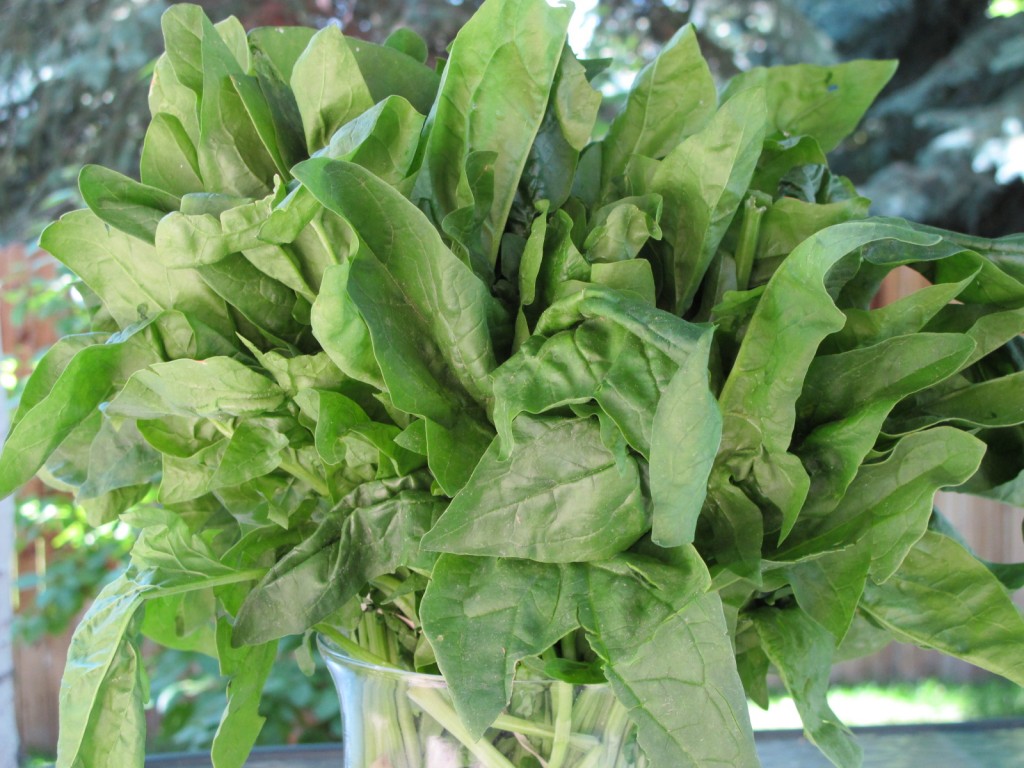
Are you having an evolutionary flashback?
Belonging to a CSA means eating according to the natural, local growing cycles. Back in the olden days, this was the only option. No avocados if you lived in Colorado. No tomatoes in the winter unless you canned them. No spinach in December.
Here in the Rocky Mountains, you can count on the possibility of snow into May (maybe longer), so June and July mean LOTS of greens (seriously, like a ton). Right now my CSA share box is overflowing with spinach. My crisper drawer is jammed. I can’t shove another leaf into it.
That’s the perceived downside to belonging to a CSA. No variety. Spinach, spinach and more spinach. Hey, we have too many options in life as it is, enjoy the simplicity. Sometimes less is more (or something like that).
Just think “primitive diet” with a contemporary twist. Spinach is our main ingredient, we simply need to resort to some creative accessorizing. How about some maple syrup to sweeten things up? Those of you who have been following this blog for any length of time might recognize a pattern here. Pure, organic maple syrup is often my answer to life’s dilemmas.
warm maple spinach salad
what you need
10 cups washed, stemmed and gently torn spinach
1 cucumber, peeled and diced
1/4 cup (or more) chopped pecans
1 shallot, finely chopped
1/4 cup cider vinegar
2-3 tablespoons pure maple syrup
1-2 tablespoons extra virgin olive oil
sea salt & fresh ground pepper, to taste
1/3 cup shredded smoked Gouda
what you do
1. Toast pecans in a small skillet over low heat until fragrant (3 to 5 minutes). Stir often. Transfer to a small bowl and set aside to cool.
2. Toss spinach and cucumber in a large bowl.
3. Heat oil in small skillet over low-medium heat. Add shallot and cook 4 to 5 minutes until softened. Stir often. Don’t let the shallot burn. Add vinegar and maple syrup and increase heat until almost boiling. Stir well. Season with salt and pepper.
4. Immediately pour the dressing over the spinach and cucumber. Toss well and sprinkle with cheese and toasted pecans.
Makes 4 large servings or 6 small ones.
As for the abundance of CSA spinach, if all else fails, make a bouquet-ish arrangement out of it. See photo above.
Go forth and eat spinach! Over and over.
Melissa
P.S. Cid, I’m counting on you to set me straight on my cheese choice. I’m guessing there’s a more fashionable accessory than smoked Gouda.
Thursday, June 17th, 2010

Farm-fresh food lovers, start your engines (salad-spinners, blenders, stovetops, VitaMixes, ice-cream makers, juicers, dehydrators). CSA season is upon us!
Okay, so we’re a little behind out here in Colorado. It’s that pesky snow thing. But, we’re a hardy bunch. We don’t let cold weather ruin our fun or our growing season. Last weekend was Grant Family Farm’s spring farm tour and CSA kick-off celebration. It was cold, rainy, dreary and muddy, but in true Woodstock tradition, spirits were high, the beer was flowing and the farm-fresh food abundant.

As I did last year, I’ll be posting recipes according to what I receive in my share box each week. Please join me in eating our way through the season.
spinach pesto
what you need
2 cups fresh spinach, washed, stemmed and coarsely chopped
1/3 cup walnuts
1/4 cup grated Parmesan cheese
3 cloves garlic
2 – 3 tablespoons parsley, washed and stemmed
1 – 2 tablespoons extra virgin olive oil
sea salt and freshly ground black pepper
what you do
Place all ingredient in a food processor and pulse. Salt and pepper to taste. Serving ideas: drizzle over roasted chicken, serve with crackers, use on pizza, substitute as a condiment in wraps or sandwiches, use as a pasta sauce. The possibilities are endless. Enjoy!
Photos courtesy of Kirsten Akens, Food & Drink writer for the Colorado Springs Independent. Please follow this link to Kirsten’s article about Grant Farms Spring Farm Tour (more photos included). Thank you, Kirsten!
Peace, love and farm-fresh food.
Melissa
Disclaimer: All material on this website is provided for informational and educational use only and
should not be used for diagnostic purposes. Consult with your physician regarding any health or medical concerns you may have.
|
|


























